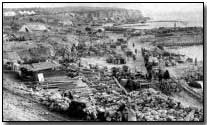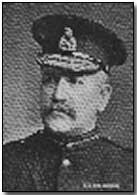Battles - The Evacuation of Anzac Cove, Suvla Bay and Helles, 1915-16
 In the wake of the failure of the Allied
attacks at Scimitar
Hill and Hill 60
beginning 21 August 1915, intended to link the two Allied sectors of
Anzac Cove
and Suvla Bay,
Mediterranean Commander-in-Chief
Sir Ian Hamilton
telegraphed London in a state of increasing despondency.
In the wake of the failure of the Allied
attacks at Scimitar
Hill and Hill 60
beginning 21 August 1915, intended to link the two Allied sectors of
Anzac Cove
and Suvla Bay,
Mediterranean Commander-in-Chief
Sir Ian Hamilton
telegraphed London in a state of increasing despondency.
Allied Desperation on the Peninsular
In his telegram Hamilton requested a further 95,000 reinforcements from British war minister Lord Kitchener. He was offered barely a quarter, 25,000. Confidence in the Gallipoli operation in London and Paris was dwindling. While former First Lord of the Admiralty and architect of the operation Winston Churchill pressed both governments to provide continued support, French General Maurice Sarrail suggested a combined offensive against the Asian coast, a proposal rapidly over-turned by his Commander-in-Chief Joseph Joffre, who insisted upon retaining French focus on the Western Front.
Salonika
 Affairs
outside of Gallipoli began to intrude upon strategy in the region. The
invasion of Serbia and plans for an extensive landing at Salonika exhausted
resources from both French and British governments, with the latter offering
to provide up to 125,000 troops (much against Kitchener's inclination).
Affairs
outside of Gallipoli began to intrude upon strategy in the region. The
invasion of Serbia and plans for an extensive landing at Salonika exhausted
resources from both French and British governments, with the latter offering
to provide up to 125,000 troops (much against Kitchener's inclination).
Such were the demands for men intended for Salonika that forces were diverted away from Hamilton in Gallipoli, to the latter's great dismay. As it was Hamilton was facing increasing criticism from London as grim news of the expedition reached home, along with complaints of his mismanagement of the campaign (from the Australian journalist Keith Murdoch among others).
Evacuation
Thus with the possibility of further reinforcements to the region seemingly ruled out, Hamilton received word on 11 October 1915 of a proposal to evacuate the peninsula. He responded in anger by estimating that casualties of such an evacuation would run at up to 50%: a startlingly high figure.
The tide was clearly moving against Hamilton. His belief in what was widely viewed as an unacceptable casualty rate in the event of evacuation resulted in his removal as Commander-in-Chief and recall to London at a meeting of the Dardanelles Committee on 14 October.
 Hamilton was replaced by
Sir Charles Monro.
Monro lost no time in touring Helles, Suvla Bay and Anzac Cove upon his
arrival on the peninsula on 28 October. His recommendation was prompt:
evacuation. This did not however meet with Kitchener's approval. He
travelled to the region to see the state of affairs for himself.
Hamilton was replaced by
Sir Charles Monro.
Monro lost no time in touring Helles, Suvla Bay and Anzac Cove upon his
arrival on the peninsula on 28 October. His recommendation was prompt:
evacuation. This did not however meet with Kitchener's approval. He
travelled to the region to see the state of affairs for himself.
Upon his arrival however he quickly reversed his thinking upon seeing the conditions facing the Allied force and recommended evacuation on 15 November 1915, overriding arguments by senior naval figures Sir Roger Keyes and Rosslyn Wemyss to attempt a naval seizure once again.
The British government, having prevaricated for several weeks, finally sanctioned an evacuation on 7 December. Unfortunately by this stage a heavy blizzard had set in making such an operation hazardous. Nevertheless the evacuation of 105,000 men and 300 guns from Anzac Cove and Suvla Bay was successfully conducted from 10-20 December 1915. The evacuation of Helles was conducted - comprising 35,000 men - from late December until 9 January 1916.
 The evacuation operation was easily the most
successful element of the entire campaign, with casualty figures
significantly lower than Hamilton had predicted (official figures quote just
three casualties).
The evacuation operation was easily the most
successful element of the entire campaign, with casualty figures
significantly lower than Hamilton had predicted (official figures quote just
three casualties).
Painstaking efforts had been made to deceive the 100,000 watching Turkish troops into believing that the movement of Allied forces did not constitute a withdrawal.
Winston Churchill however viewed Monro's achievement with a somewhat jaundiced eye: "he came, he saw, he capitulated" he wrote of Monro, and the sneer has remained through the years to blight Monro's correct decision and remarkable follow-through.
Casualties
480,000 Allied troops had participated in the Gallipoli campaign which comprised the Turkish Army's most significant success of the war. Of this figure 252,000 suffered casualties (of these 48,000 were fatalities). One-third of the 33,600 Anzac casualties comprised fatalities.
Turkish casualties have been estimated at 250,000, of which at least 65,000 are believed to be fatalities.
Eventual Access to the Narrows
Following the evacuation the Allies continued to block Mediterranean access to the Dardanelles Straits until Turkey's collapse and exit from the war at the end of October 1918.
With Turkey's defeat the British and French lost little time in assembling a sizeable fleet which duly re-entered the Straits in some ceremony and finally sailed into the Narrows en route to Constantinople.
To view maps detailing the progress of the Gallipoli campaign click here; and here; and here; and here.
Photographs courtesy of Photos of the Great War website
A 'whizzbang' was a high-velocity, low-trajectory shell that made a shrill approach noise and then a sharp explosive report.
- Did you know?
